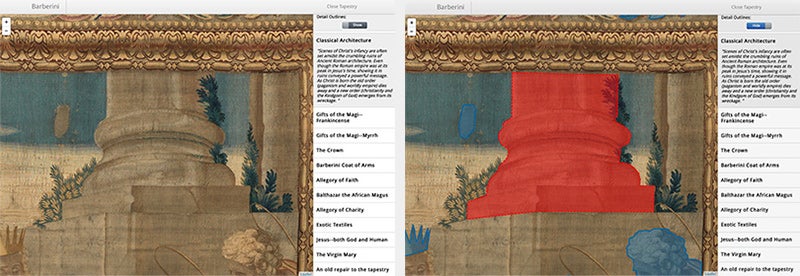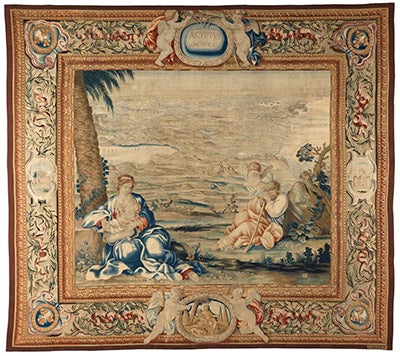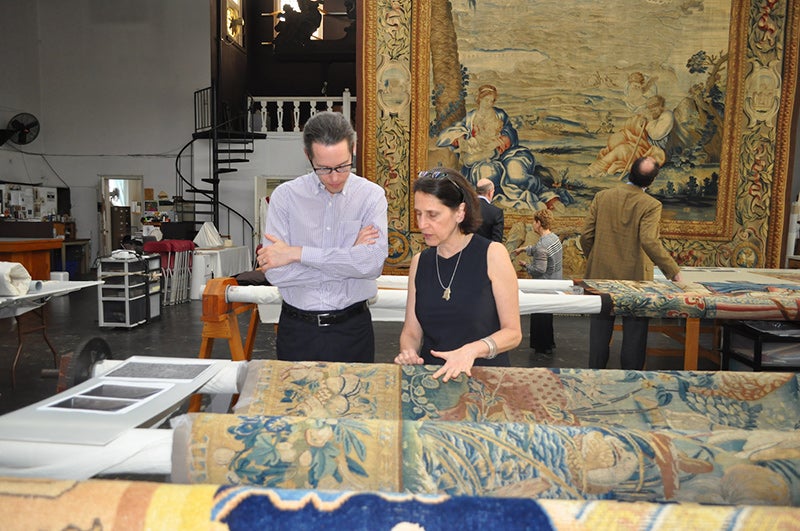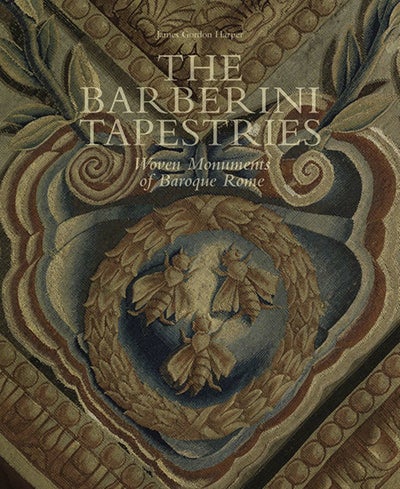A monumental set of ten newly restored 17th century tapestries that once hung in the Vatican will be exhibited in two cities in 2017-18: New York and Eugene. The Jordan Schnitzer Museum of Art (JSMA) will display the Barberini Life of Christ, one of the most important surviving examples of baroque tapestry, from September 23, 2017, through January 21, 2018.
If getting them to Eugene wasn’t enough of a coup, the installation style for the tapestries will also set a precedent.
“We’re planning to hang this series in 17th century style, in an immersive environmental wraparound hang, so that the viewer walks into the room and is entirely surrounded by tapestry,” University of Oregon art history professor James Harper said of the series. With each panel nearly 16 feet tall and between 12 and 19 feet in length, the massive Life of Christ promises quite an immersion.
“Museums tend to hang tapestries like paintings, with a decorous amount of white wall space providing breathing room between each object. But tapestry is meant to leave us breathless.” Harper said. “Seeing a true Baroque style wraparound installation will let our visitors understand something of the richly luxurious, visually warm, sensuously enveloping experience that makes tapestry unique.”
To further enhance the visitor experience, museum patrons will be able to explore the tapestries in high-resolution detail on two interactive iPad kiosks.
“Using an interactive feature on the iPads, users can zoom in or pan around any of the images of the tapestries. The same application will also be available on the web for anyone to explore,” said Ken Kato, director of UO Campus GIS and mapping, who is overseeing a team of digital specialists creating the touchscreen panels.

Above: Using an interactive feature on iPad kiosks in the exhibit, users can zoom in or pan around images of the tapestries. In these images, the kiosk user has selected the “Classical Architecture” detail area to learn more.
“The project is great match for my team’s innovation and creativity and they’re thoroughly enjoying a project that allows them to engage on an academic research endeavor,” Kato said.
The digital team’s work on the Barberini exhibit builds on a “successful and fun collaboration” in 2010 with Harper and architecture Professor James Tice on the the Vasi exhibit, Kato said.
Campus wide, faculty are being invited to develop interdisciplinary programming to extend the research scope of this rare installation.
“We’ll have a robust set of programs to accompany the exhibition, on topics ranging from weaving to 17th century history to religion, and we’ll also host a symposium that brings some of the top people in the field here,” Harper said. “This is a perfect example of the frequent collaboration between the museum and the School of Architecture and Allied Arts, and demonstrates both the value of our school to the museum and the value of the museum to our school.”
The Life of Christ tapestry series was commissioned in 1643 by Cardinal Francesco Barberini, the nephew of Pope Urban VIII and a key figure in the political and cultural worlds of baroque Rome. Fabricated over a 13-year period, the tapestries once hung in St. Peter’s Basilica in the Vatican and at the Palazzo Barberini in Rome.

Above: The Rest on the Flight into Egypt, tapestry from the Life of Christ series, designed by Giovanni Francesco Romanelli and woven from a cartoon by Paolo Spagna (with border cartoons by Paolo Gismondi) in the Barberini Manufactory, Rome, under the direction of Caterina della Riviera, 1653. Image courtesy James Harper. Click the image above to enlarge.
The magnificence of Barberini tapestries caught Harper’s attention early on; his PhD dissertation focused on a tapestry series made in the same workshop that wove the Life of Christ. Harper’s research examines the connections between art and power with a focus on monumental biographical imagery. He is one of the world’s top specialists in 17th century Italian tapestry.
“The hallmarks of tapestry are its portability and its versatility,” Harper said. “Tapestry compares most readily in its structure with fresco: It covers walls, it often has architectural framing elements, it is environmental. But unlike fresco it’s portable. You can move it outdoors to line a parade route. You can hang it indoors in a church, you can hang it in a palace. If you have a large room you can hang all the panels; if you have a small room you can hang just four of the panels. Or if you want to use a single panel as an altar piece, you can do that too.”
The same exhibition style to be used at JSMA will debut March 19 in New York at the Cathedral Church of St. John the Divine, which has owned the tapestries since 1891. Harper will speak at the opening reception at the cathedral, and the Life of Christ panels will be on display there through the summer before the installation moves to Eugene.
Given his expertise, Harper was invited to write the monograph, The Barberini Tapestries: Woven Monuments of Baroque Rome, that will accompany the exhibition. Officina Libraria, one of the premier art publishers in Europe, will release the volume in March 2017.
In the competition for the magnificence that animated 17th century Rome, the Barberini dazzled their rivals by founding their own tapestry workshop, or “manufactory,” to create custom-woven designs.
“In the 17th century, tapestry was so expensive and so labor intensive that to have your own private tapestry manufactory was a gesture on a royal level,” Harper said. “Most of the manufactories took in work from anybody to help pay their bills, but the Barberini manufactory did not. They just served at the pleasure of the Cardinal, who kept them busy by commissioning seven tapestry series over 50 years. The Life of Christ sits right in the center of the workshop’s activity.”

Above: An event at the Cathedral's Textile Conservation Laboratory marked the start of the conservation project after the 2001 fire. At left is Professor Michael Cole of Columbia University. At right is Valerie Soll, Senior Textile Conservator at the lab. Soll (BA '75, fibers) studied at UO under Barbara Pickett.
Aside from sponsoring the weaving of tapestries in Rome, the Barberini family also collected tapestries from across Europe. They amassed the greatest tapestry collection in Rome—literally “hundreds and hundreds,” Harper said—and used the collection not only for display in their palaces but also for lending out to institutions and individuals. In doing so, the Barberini reinforced their political networks and amassed social capital with the borrowers, who could then be counted on for loyalty. And because Barberini ownership was evident in many of the tapestries—which included heraldry and other markers of the Barberini—loans from their collection advertised the importance and the generosity of the family to the Roman public who saw the tapestries at festivals and other events.
“This [Life of Christ] series was one of the standard, “go-to” ones for loaning out,” Harper said.
The lenders kept precise records, noting borrowers’ names as well as events. “The guardarobbiere would sign off on loans of tapestry series if a church was having its feast day, if the university was having graduation, or if some family friend was having a wedding,” Harper said. Looking through these record books, “we can not only see where things went but we can also reconstruct social and political networks. It’s really rich data.”

Above: Art history Associate Professor James Harper.
Harper wrote six of the monograph’s seven chapters. The seventh chapter, written by Marlene Eidelheit, director of the Cathedral Church of St. John the Divine’s celebrated Textile Conservation Laboratory, explores the conservation history of the tapestries after the cathedral acquired them.
The idea for the Barberini exhibition began in 2011, as a decades-long conservation project on the tapestries was nearing completion. That effort saw a major setback in a December 2001 when a fire at the cathedral permanently damaged two of the tapestry panels, the Resurrection and the Last Supper. Four others had reversible smoke damage, while the remaining six were unscathed. Conservation efforts already under way were redoubled, and Eidelheit asked Harper if he’d author a book to celebrate what was now, almost literally, “a phoenix rising from the ashes.”
The exhibitions in New York and Eugene, and Harper’s monograph, will tell the tapestries’ story in full, encompassing how they were designed, woven, installed, restored and conserved. In addition to shedding light on these artworks as both aesthetic experience and cultural artifacts, the exhibit will also explore the festival life of Rome.
Harper is just one of a large team behind the Life of Christ installations in New York and Eugene. Along with the digital interface created by Ken Kato, director of UO Campus GIS and mapping, the installation will be overseen by Kurt Neugebauer, JSMA associate director and his team, including Chief Preparator Joey Capadona.

Above: UO Associate Professor James Harper was invited to write the monograph that will accompany the Barberini exhibition at the JSMA and in New York. Image courtesy Officina Libraria.
